Scene layers is the key to really elevating the success of your scenes by making them work harder.
1) Plot, Character, and Theme
The highest form of scene incorporates the techniques already discussed and layers of the holy trinity of any story.
I’m pretty sure everyone knows what plot and character is but theme always seems to be a bit of a challenge.
Theme is the reason we’re creating something; the life lesson so to speak. Why does this work exist and/or how does what happens change the character?
Google’s dictionary provided by Oxford Languages says this: Theme is, “An idea that recurs in or pervades a work of art or literature. “
So, ‘power corrupts and absolute power corrupts absolutely’ is a great definition of theme. Movies like Wall Street, and almost any gangster film, Scarface, Casino, even teen dramas like Clueless or Heathers define this theme about power.
Combining plot, character, and theme in one scene form a perfectly layered scene.
How?
If you understand your character and their backstory you can easily show plot, character, and theme. Plot will direct your character in their actions based on who they are, who they have become.
Iron Man and Captain America are both superheroes fighting for good but each act differently given their disparate backgrounds. They talk differently, respond to situations differently etc. So, plot, the way they think and react, is determined to a large extent on who they are, who they’ve become.
Tony Stark is brilliant, privileged, arrogant, and self-important. Cap is none of these things. Creating a scene with one will have different outcomes from the other even though both are determined to fight evil.
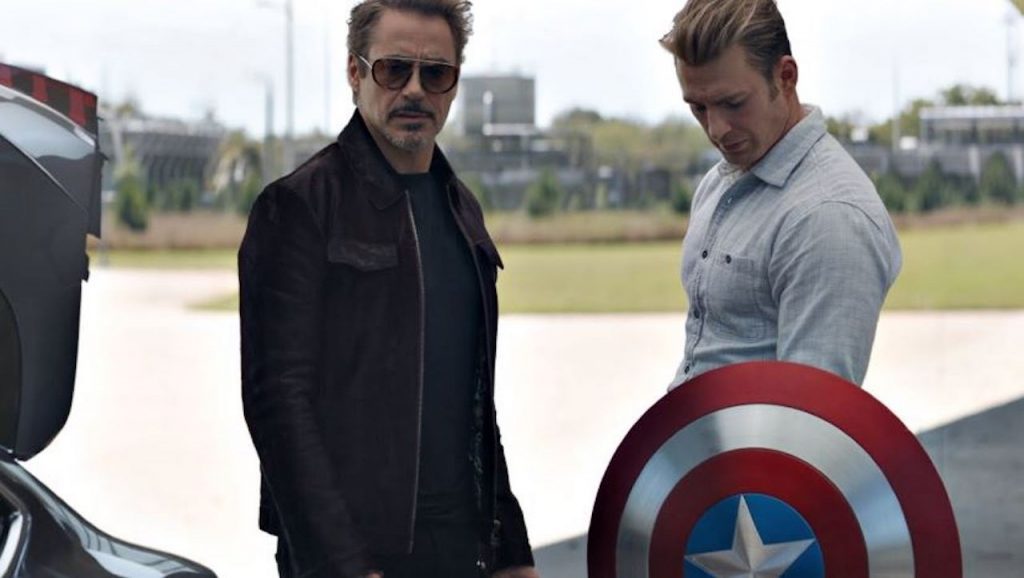
Iron Man/ Tony Stark (Robert Downey Jr.) and Cap/ Steve Rogers (Chris Evans) Photo courtesy of Marvel Studios
Theme is the lesson you’re trying to teach them (and your audience), so then of course, Tony Stark has different lessons to learn than Steve Rogers. You can see a lot of this played out in Captain America: Civil War when each man takes a different side to the main plotline. Given their character differences leads to them both acting differently under the same circumstances and then learning different lessons.
Really, it’s about their backgrounds. This same principle is at play in most films.
T’Challa in Black Panther does almost everything based on his background as the son of a king, a super-powered protector, and as an all-powerful ruler of a kingdom. Because of this, his ego drives his actions, his thoughts, his dialogue in almost every scene. He will learn the lessons here – the theme, of acting out of ego. It may seem obvious but this is much different than his sister, Shuri’s, responses who was raised in the same household.
The Verdict
Yes, this movie is decades old. Yes, the courtroom drama feels overly familiar at times because there’s been so many lawyer TV shows and movies since. But no movie I’ve ever broken down has illuminated the concept of layers better. Black Panther comes close. But actually, almost any well-written film also does but nothing like this David Mamet/Sidney Lumet/Paul Newman masterpiece.
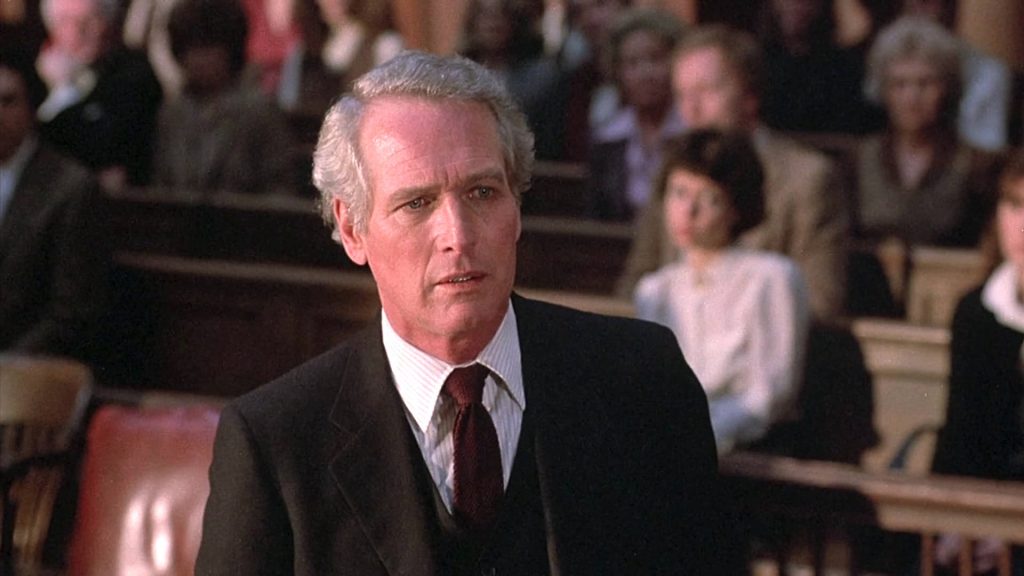
Frank Galvin (Paul Newman) in The Verdict
The Verdict tells a fairly simple story about an attorney who has lost his way. He’s become an ambulance chaser and hates himself for it. An event in the past has sent him into this downward spiral of alcoholism and despair. He is given one more case to set him up for life financially. He actually has a settlement check in his hands, and suddenly decides not to take it. He instead opts for a jury trial which he probably won’t win. The scene when his clients find out he has rejected the settlement offer is one of the most tense scenes I’ve ever witnessed but it’s just one of many well-crafted and layered scenes.
Almost every moment in The Verdict features plot, character, and theme. The theme being corporate and institutional greed and betrayal. Insurance companies, the legal profession, the church, doctors, and lawyers all conspire to deprive a young mother of active life.
She’s in a coma. Instead of helping her, which is what these institutions are supposed to do, they all try to wiggle out of responsibility and shoot for the least culpability in her injury that’s possible. But more than that, these institutions also gaslight her family, the public, and her attorney.
Newman’s character himself was betrayed by institutions and it caused him to begin a downward spiral of alcoholic despair. He sees himself in the young mother and rallies to help her. Problem is, he’s doing the exact same thing to her and her family that had been done to them (and him) by the other institutions – a startling and genius layer of this film.
To have your main character not only reflect exactly what put them into their current position but then have that character acting in exactly the same way – that’s just masterful writing.
Every scene in The Verdict manages to:
- Further the plot,
- Illuminate and deepen the character, and,
- Express the theme of institutional betrayal.
2) Dense and Compelling
This allows all these scenes to be incredibly dense and compelling moments.
For example, here’s where Newman’s character (Frank Galvin) turns down the settlement.
GALVIN
That that poor girl put her trust in
the hands of two men who took her
life, she’s in a coma, her life is
gone. She has no family, she has no
home, she’s tied to a machine, she
has no friends — and the people who
should care for her: her Doctors,
and you, and me, have been bought
off to look the other way. We have
been paid to look the other way.
I came in here to take your money.
(beat)
I brought snapshots to show you. So
I could get your money.
(waving away check)
I can’t take it. If I take it. If I
take that money I’m lost. I’m just
going to be a rich ambulance chaser.
(beat)
I can’t do it. I can’t take it.
Why is this so notable?
Plot: He’s going to try the case instead of taking the guaranteed money in the settlement. That’s huge. A crucial tentpole moment for the plot.
Character: He’s come to the realization that he’s in a hole so deep in his life that he might not be able to climb out. This case signals the beginning of his catharsis and leads to his redemption. Pivotal to bring him into balance even if he’s doing this for the wrong reasons.
Theme: Should be obvious by now – he says it and in a moment of clarity includes himself. His client has been betrayed by all the institutions that should have protected her.
All of these important layers are integrated seamlessly into that scene and it’s only one of many where that happens.
More Examples
I honestly could breakdown the entire Verdict movie scene-by-scene and show that every one of them does this layer thing where all these concepts are used. Let me show what these concepts have in common with other great movies.
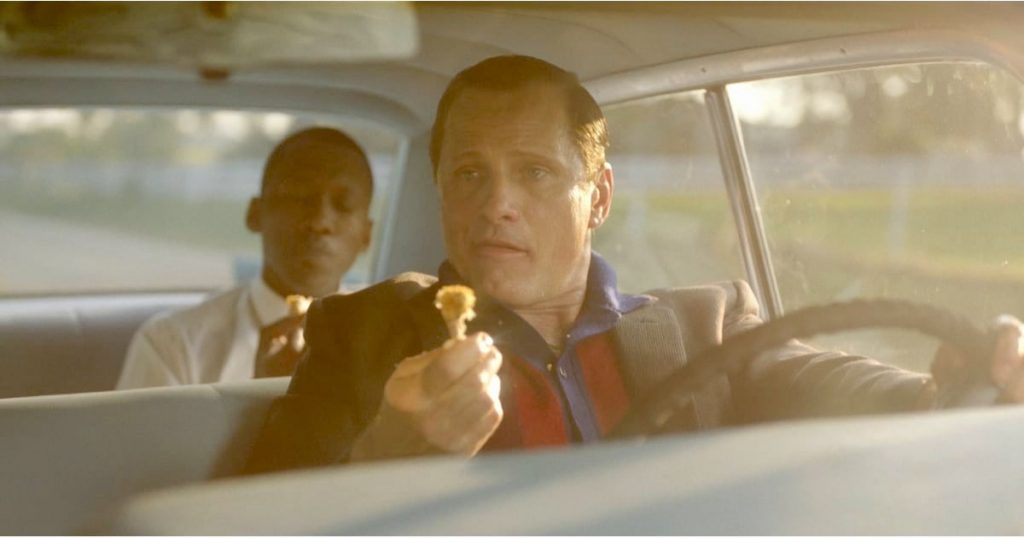
Dr. Don Shirley (Ali Marhashala) & Tony Lip (Viggo Mortensen) in Green Book
In Green Book there’s a moment when Lip (Viggo Mortensen), the man he’s hired to drive is eating fried chicken. Dr. Shirley (Mahershala Ali) says he’d never eaten fried chicken which shocks Lip.
DR. SHIRLEY
I’ve never had fried chicken in my life.
LIP
Who you bullshittin’? You people
love the fried chicken, the grits,
the (sic) colored greens…
DR. SHIRLEY
You have a very narrow assessment
of me, Tony.
LIP
Whoa, wait a minute. If you said
all guineas like pizza and
spaghetti and meatballs, I’m not
gonna get insulted.
~cut~
Lip takes a piece of chicken, holds it out to Shirley.
LIP (CONT’D)
Just grab it and eat it!
DR. SHIRLEY
No.
LIP
I’m gonna throw it in the back seat.
~cut~
Shirley takes a bite. Lip can see he’s enjoying it.
~cut~
DR. SHIRLEY
What do we do about the bones?
LIP
We do this.
Lip throws his bones out the window. After a BEAT, Shirley
rolls down his window and does the same.
They smile at one another for the first time.
Then Lip finishes his Coke and TOSSES THE CUP OUT THE WINDOW.
As Shirley loses his smile, we cut to:
Plot: This is the first moment they bond, a process that will form the backbone of the story as it unfolds.
Character: Both men learn something about each other and that is part of the charm and point of the story. They are from such disparate backgrounds and each is written both to type and against type. This scene is a good example what made this such a strong character movie.
Theme: Set in the 60’, the entire movie is an indictment of racial bias and inequality. Here, two men show the stupidity of racism as they connect over a stereotype, fried chicken which an Italian street guy loves and an African American concert pianist had never eaten it.
Green Book has many, many scenes that layer in all these elements.
Casino Royale
James Bond movies are always well-written and feature some of the best action sequences ever put on the screen as befits the 60-yr-old franchise. But even the non-action scenes are jewels.
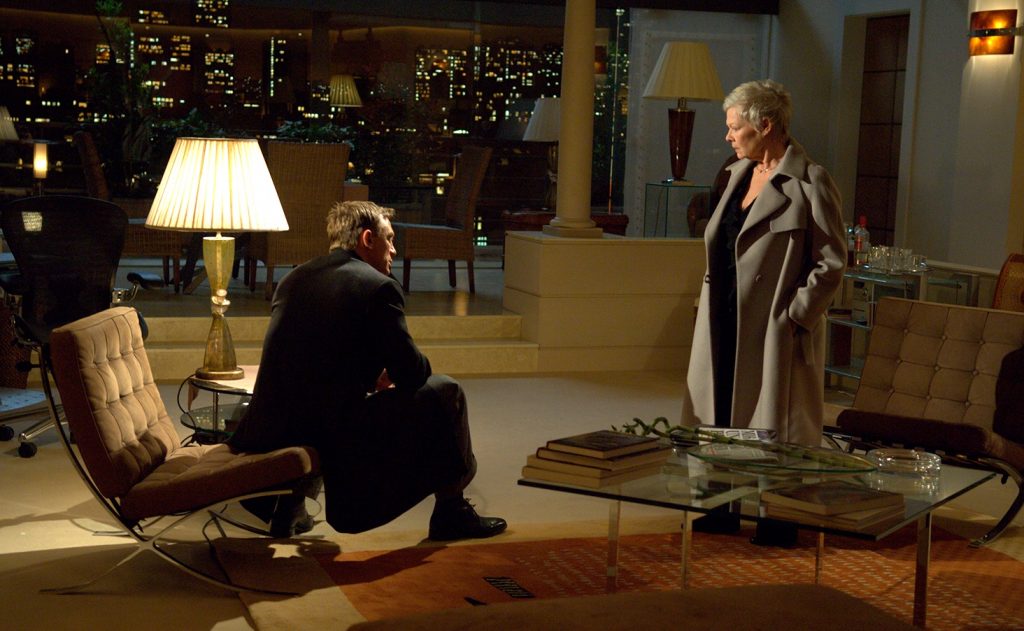
James Bond (Daniel Craig) & M (Dame Judi Dench) Photo courtesy of MGC Studios
In the 1st Daniel Craig Bond film, after some rousing action, M comes home to find Bond perched on a table. The scene is the first time we’re seeing Bond interacting with M in this reboot. Quite a different relationship from previous M/Bond moments especially since Bond has just been promoted to double-O status.
M
You’ve got a bloody cheek.
BOND
Sorry. I’ll shoot the camera first next time.
M
Or yourself.
~ cut ~
M
For God’s sake. You’re supposed to display
some kind of judgment. We’re trying to
find out how an entire network of terrorist
groups is financed and you give us one
bomb-maker. Hardly the big picture,
wouldn’t you say?
(beat)
The man isn’t even a true believer.
He’s a gun for hire. And thanks
to your trigger finger we have
no idea who hired him or why.
(beat)
I knew it was too early to promote you.
BOND
Well, I understand double-O’s have a
very short life expectancy. So one can
hope your mistake isn’t long-lived.
~ cut ~
M
Bond, this may be too much for a
blunt instrument (like yourself) to understand, but
arrogance and self-awareness
seldom go hand in hand.
(beat)
Go and stick your head in the sand
somewhere and think about your future.
Plot: This is our first introduction to M and this new, rougher iteration of James Bond. Their relationship softens as the franchise proceeds, but this is a sort of an origin point where he first becomes a double-0 agent and he’s called to task for his grievous missteps.
Also, he was actually there to steal information from M’s computer which will lead him to the bad guys. After his mistake in Madagascar, he knows M will take him out of the field so he has to find leads elsewhere.
Character: So much to unpack here. He’s breaking into the head of MI-6’s flat. Stealing information. And he doesn’t run away but waits for her to show that he did. He is wholly disrespectful to his boss who is one of the most powerful people in the country.
I remember how arrogant he came across in this when I first saw it and I loved it. This Bond not only disregards authority but he’s a bully boy about it.
Plus, M herself is large and in charge. She simply won’t broach his nonsense. This scene not only sets them up for the film but for the entire five film run.
Theme: M says it directly in this scene: “Bond, this may be too much for a blunt instrument to understand, but arrogance and self-awareness seldom go hand in hand.”
Bond’s arrogance will cause him to lose the love of his life leading to more self-awareness in future movies.
Brilliant, dense, and fun writing all around.
One Flew Over The Cuckoo’s Nest
One final example.
I define ‘writing class movies’ as those which make their way into every movie class discussion because they’re so good. One Flew Over The Cuckoo’s Nest qualifies and I can’t not mention it here.
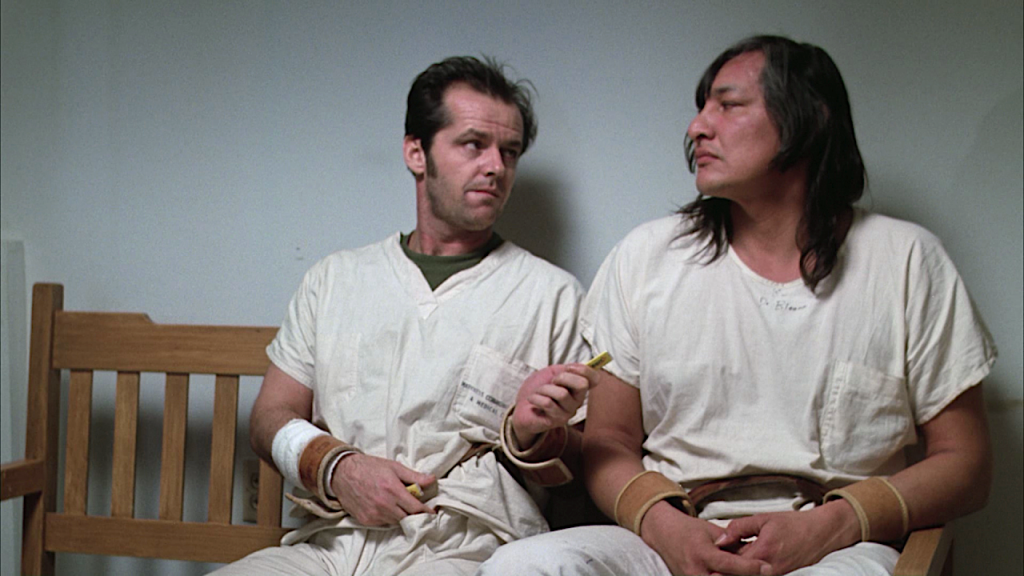
Randall McMurphy & Chief Bromden (Will Sampson) in One Flew Over The Cuckoo’s Nest
Randall McMurphy (Jack Nicholson) is sitting with who he thinks, who everyone thinks, is a deaf and mute patient named Chief (Will Sampson). McMurphy offers Chief Bromden a piece of gum and this ensues.
McMurphy gives (Chief) Bromden a stick of gum.
BROMDEN
Thank you.
McMurphy looks up, shocked. A long beat. Offers Chief another stick.
BROMDEN
Ah, Juicy Fruit.
MCMURPHY
Well, you sly son-of-a-bitch!
Does anyone else know?
~ cut ~
MCMURPHY
Shit! This is too much! Chief,
I tell you we’re gonna bust
outta this place an’ make it all
the way to Canada before they know
what hit ’em.
BROMDEN
Canada.
MCMURPHY
Shhh, Chief, don’t talk. Never
talk! Remember, this is just
between you an’ me. Do ya understand?
Bromden nods.
Plot: This is the moment where an escape plan is formulated with the Chief which leads to one of the most heart-rending and inspirational endings ever. The men bond over a stick of gum and become fast friends who conspire to thumb their noses at the system by playing along and then planning to escape.
Character: Both men are pleased with themselves. McMurphy has found a kindred spirit who is pretending to be deaf and dumb in defiance of society’s rules, and Chief likewise sees himself in McMurphy albeit a much louder and vociferous version of himself. Chief, who despite his physical size considers himself small, is lifted up by McMurphy’s strength later on and that begins here.
Theme: All through the 60’s and 70’s were movies about anti-heroes who didn’t, couldn’t conform to society’s norms. Easy Rider, Cool Hand Luke, A Clockwork Orange and this movie were prime examples.
The idea of individual freedoms, working against what is expected of you, is thematically infused everywhere in this film.
Louise Fletcher just passed away. Her bravura performance as Nurse Ratched defined an entire generation of protest against societal norms. Her pitch-perfect turn had us hating compliance and bullies which Fletcher’s character embodied perfectly.
The theme here is that you can rise above the shackles that are put on you. Sometimes, though, it requires the ultimate sacrifice. This also dovetails into the thematic concept of boundaries of self-determination. Heady stuff.
Both McMurphy’s refusal to comply and the Chief’s quiet protest by pretending to be deaf and dumb show this. This sensibility is perfectly reflected in all scenes in this film as McMurphy (and others) go head-to-head with Nurse Ratched.
Conclusion
Scenes are so much more than dumping information in the form or dialogue or narrative on a page. Sure, we do that when we start but as you learn your craft it’s essential that you raise your skill level to layer in other things to make those scenes sing.
Then, of course, there’s subtext.
That’s for another discussion.

